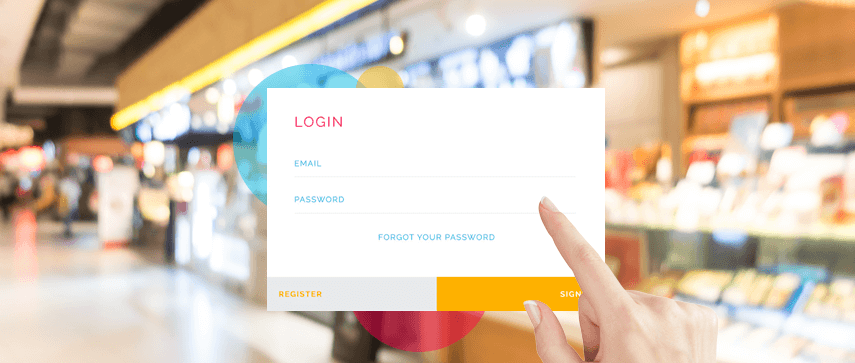The COVID-19 pandemic hasn’t been kind to retail businesses. With global economies plunging by up to 8%, retailers have had a hard time surviving and retail stores were forced to shut down. Those who managed to survive were barely bringing in revenue. Additionally, COVID-19 is paving the way for new opportunities in retail spaces. One of them is the increasing need for online retail sales and retail store app.

Today we’ll delve deep into how COVID-19 has impacted the retail industry and how the technological transformation is leading the path to revival.
Repercussions of COVID-19 on Retail Businesses Transforming Consumer Shopping Behavior
The COVID-19 pandemic is modifying a lot of things including consumer shopping behavior. It is changing the way people live, think, and make purchases. Consumers across the globe are looking at products and businesses from an entirely different perspective. But the impact of this paradigm shift hasn’t been pleasant for retailers. Supply chains have been under the sway of altering customer demand, leaving retailers no choice but to shut their doors.
The impact has been more prominent in countries like India, where the GDP has plunged by more than 20%. While the online retail business industry in India was surging, the majority of the population preferred shopping offline before the pandemic. Similarly, companies in the US are witnessing this rapid change in retail. Being the country with the highest recorded active cases of COVID-19, the US is lagging in terms of performance than economies in the UK and Germany.
The changing times are paving a new path in the way people shop. Adobe’s Digital Economy Index report showed that the US online spending had hit $82.5 billion in May 2020, showing a 77% year-on-year rise.
The sudden shift in consumer behavior has left almost every retail business baffled. Business owners are having a hard time figuring out the customers’ needs. Albeit, the unforeseen circumstances, you can still have a significant competitive edge if you understand your customers.
How Are Consumers Thinking?
The impact of COVID-19 seems to be subsiding, but consumers are still concerned and intimidated. They are taking all the necessary protocols and following social distancing norms reducing the risk of transmission and adopting contactless ways of shopping. When shopping for essentials items like consumables and hygiene products, consumers have ditched interacting with CPG brands and retail stores selling non-essential products.
The New Consumer Behavior
So, how are consumers adapting to the new normal? Two major changes have come to light. First, shopping behavior has shifted from requirements to necessities. Consumers are prioritizing their most basic requirements like food, hygiene, and cleaning products. The second major trend is the rise of digital commerce. Online retail sales have witnessed a massive boost during the pandemic, as more people are indulging in online shopping.
To sum up, the coronavirus pandemic has catalyzed the following long-term trends:
- Increasing focus on health
- Consumption of necessary items
- The rise of online retail sales
How Are Retailers Adapting?
The retailers across the globe have been quick to adapt. Since the beginning of 2020, retailers have been struggling to stay afloat. To ensure survival, they’re shifting from business continuity to crisis management. The priority for retailers, at this moment, is to manage supply constraints, cope with staff shortages, and move to the survival minimum.
The shift to digital commerce is another massive transformation being witnessed. Retailers are planning for the long haul as they’re delivering on-demand online, but economically, keeping business survival in mind.
Ensuring Opportunities for Retail Industries Post-COVID-19
Retailers are finding themselves going above and beyond taking extraordinary measures to ensure survival. While sectors like food, grooming, Medicare, and baby care managed to stay afloat, segments like fashion and electronics crippled.
As the year approaches the end, new retail trends have emerged. Let’s discuss some opportunities for the retail industry post-COVID-19.
1 E-commerce Growth and Innovative Digital Services
In these times of crisis, the online retail business is giving retailers hope. While the future of brick-and-mortar sales is unpredictable, online retail sales could grow by 18% in 2020 and beyond. This comes out as no surprise, keeping in mind the growth of digital commerce. Research by Waitrose showed that more than 60% of consumers are shopping for groceries and essential products online.
2 Increasing Focus on Customer Experience
The pandemic is teaching us that consumers want to stick to the brands they trust. Even after the pandemic ends, customers won’t readily switch brands. Thus, retailers can increase customer loyalty by providing unparalleled customer experiences.
3 A Unique Holiday Season
The amplification of the online retail business is gaining clarity as the upcoming holiday season will be magnifying the trend. With Christmas right around the corner, consumers are looking forward to pressing the full throttle when shopping online. Hence, retailers need to be prepared for a sudden surge in demand and traffic. They are keeping their staff and infrastructure ready to cater to the increased demand during this unusual holiday shopping season.
4 Self-Innovative Service Solutions
With consumers limiting interactions with each other, self-service solutions are becoming the new norm. To comply, retailers are deploying solutions powered by technologies like AI and Infrared to provide a better, personalized in-store customer experience. After the crisis ends, customers would want complete control over their shopping journey. Thus, implementing technologies that facilitate self-service behavior will be a key opportunity for retailers.
5 New Ways to Fulfill Orders
Curbside pickup and Buy-Online Pick-Up In-Store (BOPIS) are gaining popularity as consumers want to alleviate human contact. Customers are prioritizing social distancing, providing alternative, safer delivery methods can help retailers thrive.
As digital commerce continues to grow, retailers should prioritize the strengthening of their IT infrastructure. Customers are turning to online retail sales as the primary shopping channel. Thus, retailers with a robust online presence adhering to the digital transformation will thrive.
Digital Transformation in the Retail Sector
Digital transformation is a major global trend making its way into every industry. Finance & banking, education, and healthcare are some sectors that have already adopted technological transformation and witnessed massive revolutions.

The retail industry seems to be the next in the queue. Traditionally, the retail sector hasn’t coped well with new technologies. When it comes to digital transformation in retail, most retailers think of implementing the latest technologies to make their business modern and innovative. While it’s essential to utilize the emerging tech, digital transformation is more about focusing on marginal improvements. It’s about leveraging technology to develop a connected environment that improves data intelligence and agility while streamlining operations and enhancing efficiency.
If you’re looking forward to implementing a digital transformation strategy, here are the four pillars to focus on.
Customer Engagement
The retail industry is becoming customer-centric, and customer engagement has emerged as the core of digital transformation. You can use channels like social media to communicate with and understand your customers better. Technologies like CRM and data analytics are facilitating strategic consumer engagement for retail brands.
Employee Empowerment
Many retailers are focusing on customers while overlooking their employees. But in these trying times, when employees aren’t certain about their future, employee empowerment is essential. You should deploy the necessary technologies that help your employees perform better and gain confidence.
Operations Optimization
The optimization of operations is another crucial pillar of digital transformation in retail. Retailers should utilize technologies to enable improved, data-driven decision making, and streamlining of operations. For example, a full-fledged ERP system can help provide operational transparency, process integration, and seamless communication.
Reimagination of Products
With customer expectations constantly changing and new technologies erupting, retailers need to keep pace with the new trends and innovations. It is crucial to utilize predictive analytics and meaningful insights to foresee the upcoming trends and changes in the retail industry.
Technology Paving New Ways for the Retail Industry
The retail landscape is going digital and technological innovation is the only way for retailers to bounce back. Although several technologies exist, there are three primary technologies that retailers should leverage.
Data Analytics
As discussed, the retail market is becoming customer-centric every day. Retail businesses need to apprehend customer expectations and make intelligent decisions to optimize their processes. This helps to become more proactive. Data analytics is a technology retailers can implement for in-depth insights into consumer shopping behavior. It can help you forecast sales, track emerging products, optimize offers, and predict future demand.
Ways in which data analytics can help retail businesses are:
- Predict Future Changes: Customer expectations are constantly changing. The key to success in this mercurial market is the ability to predict those marginal behavioral shifts and optimize accordingly. Adequate implementation of data analytics can help predict future changes.
- Price Optimization: Optimum pricing of products is essential. Data analytics enables price optimization, helping businesses determine price fluctuations, and adjust accordingly.
Artificial Intelligence (AI)
From product development to post-sales service, Artificial Intelligence (AI) is finding applications in every aspect of retail. Here’s how AI is helping retailers transform their operations:
- Improved Customer Service: Customer service has become the cornerstone of retail. AI-enabled chatbots are playing a pivotal role in streamlining customer interaction, support, and service in the online retail sales industry.
- Data Accumulation: Retailers have access to humongous amounts of data, but they don’t know what to make of it. With AI, you can make sense of the data collected to draw conclusions and provide a personalized shopping experience to customers.
Internet of Things (IoT)
Internet of Things (IoT) is another emerging technology that has catalyzed digital transformation in the retail industry. Here’s how retailers can implement IoT to enhance their operations:
- Robots: Countries like the US and China are exploiting the technology to deploy collaborative robots (IoT), which work side by side with humans to make operations faster and efficient while increasing staff productivity.
- Automated Checkouts: As the pandemic continues to spread, consumers are taking all the possible measures to reduce human contact. With IoT implementation, retailers can enable automated checkouts and provide enhanced experiences to customers.
Benefits of Leveraging Technology in Retail Operations
Retailers in the post-pandemic era will require agility, speed, and efficiency. They need to stay on top of changing customer demands and future trends. It is also crucial to optimize your operations and reduce costs. With the adequate implementation of technology, you can achieve all these objectives. Let’s look at the advantages of technological transformation for retail businesses.
i Multiple Payment Methods
Consumers prefer instant, contactless payments when they shop on the go. This has led to the surge of digital payment methods, such as cards and e-wallets. By implementing technology in your retail environment, you’ll be able to provide multiple payment options, thereby catering to a broader customer base.
ii Streamlined Inventory Management
Inefficient inventory management has been the biggest roadblock in understanding consumer demand for retailers during this pandemic. With the right technology in place, you can determine the amount required to fill your inventory every month. It also helps to determine which items are in demand and which are not. Electronic inventory control can help to reduce inventory costs. When it comes to inventory management, expenses for storage, handling, capital, ordering, stick-out, and carrying are involved. Digital transformation can go a long way in determining inventory costs.
iii Social Media and Increased Sales
SEO and search engine advertising are becoming competitive as retail brands are switching to social media. A V12 Data report showed that 90% of social media users reach out to retailers through social media. While social channels may not bring the last click before purchase, they play a vital role in facilitating the buyer’s journey. With the right tools and technology, you can turn social media into an automated sales machine.
iv Improved Forecasting
With AI and predictive analytics in place, you can create accurate and calculated demand forecasting consolidating past sales data and customer insights in one place. This enables faster, data-driven decision-making. The current retail scenario is displaying a bleak error of margin. One small mistake can rule you out of the race. But on the positive side, one right decision can provide you with a major edge over your competitors.
v Enable Omnichannel Retail
While digital e-commerce is reaching new heights, offline retail still has its place. Despite COVID-19 disruptions, offline retail is projected to revive as people are starting to step out of their homes. This has led to a dire need for omnichannel selling. A report by Aspect Software showed that retail businesses adopting omnichannel selling achieve a 91% higher YoY customer retention. Technological adoption can operate omnichannel. Building a digital presence and integrating it with offline operations can offer a unified experience to customers.
Mobisoft’s Digital Solutions For Retailers Assisting in Technological Transformation
Digital transformation is the need of the hour for retail businesses. But since the majority of the retail sector has stuck to traditional operations, a sudden shift to technology and digital processes can be challenging. Mobisoft can help.
At Mobisoft, we follow a proven process to implement digital transformation for your business. Here’s a quick look into our approach:
- Determining the need for transformation
- Ensuring smooth, human-centric cultural shifts
- Implementing ROI-driven, impactful transformations
- Choosing the right technology as per requirements
- Ensuring seamless collaboration between teams, partners, and stakeholders
- Making consistent improvements as per feedback
- Facilitating hassle-free transitions
Mobisoft carries proven experience in helping brands become digitally and technologically competent. Our expert solutions, including eCommerce mobile app, scanning solutions for retail, and on-demand solutions, that enhances the transformation process efficiently. Digital transformation in retail is crucial and should be implemented carefully. Retail brands need to ascertain how exactly technology can fit into their existing retail environment. That’s where Mobisoft Infotech truly shines.

Wrapping Up
The future of offline retail remains in jeopardy. But with online retail sales skyrocketing, retailers have a way to bounce back. Digital transformation has become the surviving medication for retail businesses. And even after the pandemic ends, digital retail will continue to grow.
Therefore, retailers need to begin planning digital transformation ahead of time. They need to strategize the transition, ensuring their business doesn’t lose operational functionality. Working alongside a digital transformation company can truly help, as you’ll get access to expert advice and proven solutions.

Author's Bio

Nitin Lahoti is the Co-Founder and Director at Mobisoft Infotech. He has 15 years of experience in Design, Business Development and Startups. His expertise is in Product Ideation, UX/UI design, Startup consulting and mentoring. He prefers business readings and loves traveling.


